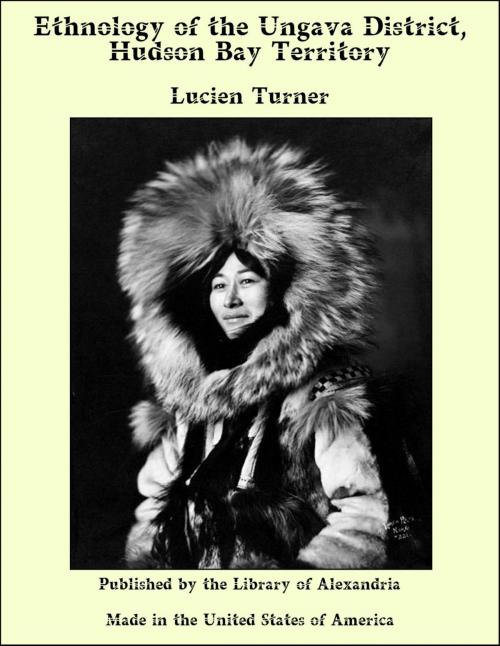Ethnology of the Ungava District, Hudson Bay Territory
Nonfiction, Religion & Spirituality, New Age, History, Fiction & Literature| Author: | Lucien Turner | ISBN: | 9781465541956 |
| Publisher: | Library of Alexandria | Publication: | March 8, 2015 |
| Imprint: | Language: | English |
| Author: | Lucien Turner |
| ISBN: | 9781465541956 |
| Publisher: | Library of Alexandria |
| Publication: | March 8, 2015 |
| Imprint: | |
| Language: | English |
Ungava bay is on the northern coast of old Labrador—the last great bight of the strait between the ocean and the mouth of Hudson bay. Its chief affluent is Koksoak or South river, which is several hundred miles long and takes its rise in a picturesque festoonery of lakes looped through the highlands half way down to Quebec. Fort Chimo is in longitude 68° 16´ west of Greenwich and latitude 58° 8´ north. The post is on the right bank of the Koksoak river, about 27 miles from its mouth. The elevation of the level tract on which the houses are situated is but a few feet above high-water mark. The location was selected on account of its comparative dryness, and also because the river affords a safer anchorage in that vicinity than lower down. The early Moravian missionaries, long before established on the Atlantic coast, desired to extend their labors for the conversion of the Eskimo to their teachings. About the year 1825 a vessel ascended the Koksoak river for the purpose of selecting a new missionary station. Nearly opposite Fort Chimo is a beacon, yet standing, erected by the people of that vessel. Their reception among the natives was such that they gave a glowing account of it on their return. The Hudson Bay Company immediately took steps to erect a trading post upon the river, and a small party was sent in the year 1831 from Moose Factory to establish a trading post where the trade would appear to promise future development. The men remained there, obtaining a precarious subsistence, as the vessel delivering them supplies visited that place only once in two years. Their houses were simple, consisting of a single structure for the official in charge, another for the servants, and two more for the storage of goods. A palisade was erected around the houses to prevent the intrusion of the natives, Indians and Eskimo, who were so lately at war with each Other that the rancorous feeling had not subsided and might break out afresh at any moment without warning. The remnants of the palisade were yet visible in 1882. The establishment of this trading post had a pacifying influence upon the natives, who soon found they could do better by procuring the many valuable fur-bearing animals than by engaging in a bloody strife, which the traders always deprecate and endeavor to prevent or suppress. After many trials to establish an overland communication with the stations on Hamilton inlet, it was found to be impracticable, and in 1843 the station was abandoned.
Ungava bay is on the northern coast of old Labrador—the last great bight of the strait between the ocean and the mouth of Hudson bay. Its chief affluent is Koksoak or South river, which is several hundred miles long and takes its rise in a picturesque festoonery of lakes looped through the highlands half way down to Quebec. Fort Chimo is in longitude 68° 16´ west of Greenwich and latitude 58° 8´ north. The post is on the right bank of the Koksoak river, about 27 miles from its mouth. The elevation of the level tract on which the houses are situated is but a few feet above high-water mark. The location was selected on account of its comparative dryness, and also because the river affords a safer anchorage in that vicinity than lower down. The early Moravian missionaries, long before established on the Atlantic coast, desired to extend their labors for the conversion of the Eskimo to their teachings. About the year 1825 a vessel ascended the Koksoak river for the purpose of selecting a new missionary station. Nearly opposite Fort Chimo is a beacon, yet standing, erected by the people of that vessel. Their reception among the natives was such that they gave a glowing account of it on their return. The Hudson Bay Company immediately took steps to erect a trading post upon the river, and a small party was sent in the year 1831 from Moose Factory to establish a trading post where the trade would appear to promise future development. The men remained there, obtaining a precarious subsistence, as the vessel delivering them supplies visited that place only once in two years. Their houses were simple, consisting of a single structure for the official in charge, another for the servants, and two more for the storage of goods. A palisade was erected around the houses to prevent the intrusion of the natives, Indians and Eskimo, who were so lately at war with each Other that the rancorous feeling had not subsided and might break out afresh at any moment without warning. The remnants of the palisade were yet visible in 1882. The establishment of this trading post had a pacifying influence upon the natives, who soon found they could do better by procuring the many valuable fur-bearing animals than by engaging in a bloody strife, which the traders always deprecate and endeavor to prevent or suppress. After many trials to establish an overland communication with the stations on Hamilton inlet, it was found to be impracticable, and in 1843 the station was abandoned.















